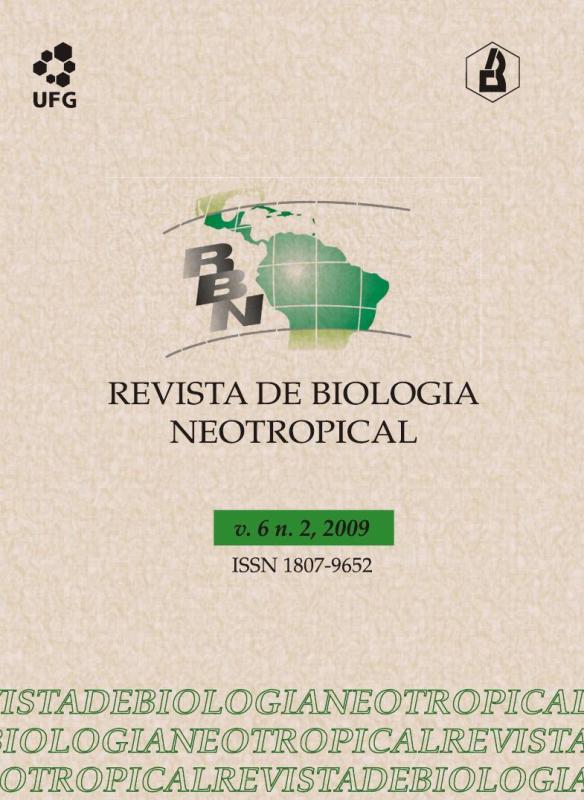Floristic diversity and reproductive phenology in phytophysiognomies of Pousada das Araras Reserve, municipality of Serranópolis, State of Goiás, Brazilian Central Plateau
Keywords:
Life strategies, phenology, phytophysiognomies, floristicAbstract
This work was carried out in Pousada das Araras Reserve (51º59’42”-52º00’22”W; 18º26’33”-10”S) in the municipality of Serranópolis, state of Goiás, in the core area of the Cerrado, Brazilian Central Plateau, aiming at studying the richness and diversity of species in plant formations and analyze their phenological reproductive patterns. Data were collected from May 2004 to June 2006. The phytophysiognomy units were identified using aerial images, global positioning system (GPS), and visual observation of ecological aspects. Fertile plant samples were collected in the usual way, numbered, dried and pressed, sorted, identified, and deposited in the Herbarium Jataiense Germano Guarim Neto (HJ). The taxawere identified according to APGII and the species were assembled in the herbaceous-sub shrub (chamaephytes, geophytes, hemicriptophytes, lianas, therophytes, hemiparasites, epiphytes) and shrub-arboreal (phanerophytes) components. As to phenological data, we registered the species that were flowering (blossom/anthesis) and fruiting (mature/
immature fruit) in each phytophysiognomy. We analyzed 3,120 registers and used descriptive statistics, qui-square test, Kolmogorov-Smirnov test, parametric circular statistics, Pearson’s correlation, and Rayleigh test. The reserve presented 101 families, 325 genera, and 554 species, distributed in seven phytophysiognomies, with high diversity and heterogeneity (H’ = 0.78; J = 0.94). The families presenting the highest floristic richness were: Fabaceae, Rubiaceae, Asteraceae, Myrtaceae, Poaceae, Apocynaceae, Cyperaceae, Euphorbiaceae, and Bignoniaceae. The typical Cerrado presented 70% of the families, 50% of the species, among which 12% were exclusive species. The humid field presented 8% of exclusive families. The relationship between shrub/arboreal and subshrub/ herbaceous components richness was 1:1,5. Flowering proved to be seasonal only in field phytophysiognomy (p ≤ 0.05), and fruiting was seasonal in the Cerrado (p ≤ 0.05) and field phytophysiognomies (p = 0.05). This work evidenced phanerogamic richness as well as heterogeneity of species and environments, pointing out the representativeness of the assessed reserve regarding the Cerrado flora. The sub-shrub/herbaceous component proved to be richer, but both components present a phenological pattern in which the shrub/arboreal species converge their reproduction to the end of the dry season/beginning of the rainy season and the sub-shrub/herbaceous species, to the end of the rainy season/ beginning of the dry season, evidencing a pulse in the communities. This study contributed to the knowledge on the flora and phenological reproductive patterns in the Cerrado in the Brazilian Central Plateau, whose ecological aspects are not well known. We should point out the need to implant projects that seek for the conservation of the studied reserve.
Downloads
Downloads
Published
How to Cite
Issue
Section
License
The expontaneos submmition of the manuscript automaticaly implies in the cession of all patrimonial rights for the Journal of Neotropical Bilogy (RBN) after publication. The autor allow the right of first publication of the article to the RBN, under Creative Commons Attribution 4.0 (CC BY-NC 4.0) Licence.
There are garanties for the authors to the authorial and moral rights, for each one of the articles published by RBN, with permissions:
1. The use of article and contents for the education and researches.
2. The use of the article and their contents, linking to the Article on the web site of the RBN, allowing the divulgation on:
- institutional closed web (intranet).
- open access repositories.
3. Preparation and divulgation of the other publication derived from the article and its content, if there is citation of the original publication by RBN.
4. Make printed copies in small quatinties for personal use.

















